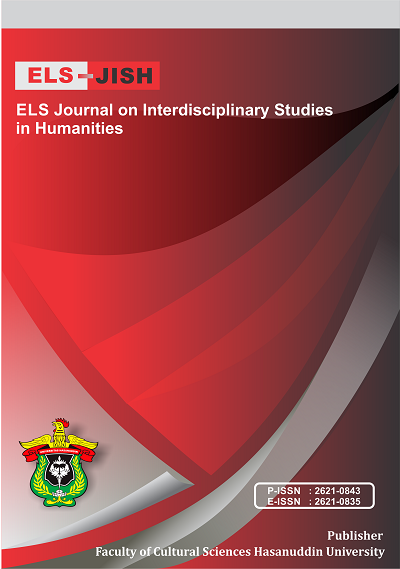Code Mixing and Japanese Grammatical Interference to Indonesian Speech in Social Media Content
DOI:
https://doi.org/10.34050/elsjish.v6i2.26913Keywords:
Code mixing interference, Indonesian speech, YouTubeAbstract
The unique culture and Indonesian lifestyle is widely listened to and it studied along with the Indonesian language learning process which is attended by many learners from foreign speakers. These foreign speakers reintroduced the Indonesian language, culture and lifestyle to the general public through various social media such as Instagram and YouTube platform. This phenomenon through the process of introducing Indonesian language especially native Japanese speakers, it creates various forms as a result of language contact including code mixing and interference. This research used qualitative method and descriptive in nature and it used sociolinguistics approach. The results of this research are found the form of code mixing and interference that appear on YouTube and Instagram content from the content, namely speech which contains code mixing and interference. The data that appears the most in the code-mixing process is in the form of groups of words and the data on the interference that appears the most is grammar at the syntactic level, followed by interference at the morphological level. Factors that cause this interference are differences in the structure of sentence patterns, differences in the process of affixation, and the process of conjugation in verbs and adjectives. The form of code mixing and interference that appears is a process of speaking Indonesian which is influenced by the sentence pattern or sentence structure of the native language of the speaker.
References
Andini, C., Sosrohadi, S., Fairuz, F., Dalyan, M., Rahman, F. F., & Hasnia, H. (2022). The Study of Japanese Women in the Facial Treatment Advertisement: A Semiotics Perspective of Pierce’s Theory. ELS Journal on Interdisciplinary Studies in Humanities, 5(2), 337-347.
Natalia, S. (2023). Interferensi Gramatikal dan Leksikal Bahasa Indonesia terhadap Tuturan Bahasa Jepang Mahasiswa Program Studi Sastra Jepang, Fakultas Sastra Universitas Nasional, Jakarta. Program Pasca Sarjana, Fakultas Ilmu dan Budaya, Program Studi Ilmu Linguistik, Universitas Hassanudin Makakssar.
Natalia, S., Darwis, M., & Abbas, A. (2022). The Psychological Constraints of Using Japanese Among Indonesian Students. Journal of Language Teaching and Research, 13(2), 331-337.
Fairuz, Rahman, F., & Amin, M. A. (2022). Authors’ Figurative Expressions From Two Novels: A Comparative Analysis Between RTJNA Rosso and RTJNA Blu. Theory and Practice in Language Studies, 12(1), 150-157.
Gafaranga, J. (2007). Talk in Two Languages. New York: PALGRAVE MACMILLAN
Grosjean, F. (2008). Studying Bilinguals. Oxford: Oxford University Press.
Haristiani, N. (2020). Code-Mixing in Japanese Language Beginner Level Classroom. In 4th International Conference on Language, Literature, Culture, and Education (ICOLLITE 2020) (pp. 469-474). Atlantis Press.
Junaid, S., Ahmad, Nurhidayah, Mujizat, A., Andini, C. (2023). The Quality of Human and Non-Human Relation in Indonesia and England Portrayed in the Selected Picture Books. ELS Journal on Interdisciplinary Studies in Humanities, 6(2), 211-218.
Keraf, Gorys (2010). Diksi dan Gaya Bahasa. Jakarta
Mahsun, M. S. (2005). Metode Penelitian Bahasa. Depok: Raja Grafindo Persada.
Miles, Matthew & Huberman, M. (2014). Analisis Data Kualitatif. Jakarta: Universitas Indonesia Press.
Nazir, M. (2005). Metode Penelitian. Jakarta: Ghalia Indonesia.
Rahman, F. (2018). The Constraints of Foreign Learners in Reading English Literary Works: A Case Study at Hasanuddin University. Journal of Arts and Humanities, 7(2), 01-12.
Said, M. M., Rita, F., Weda, S., & Rahman, F. (2021). English Language Performance Development Through Extracurricular Activities At Faculty Of Teacher Training And Education Tadulako University Palu. PalArch's Journal of Archaeology of Egypt/Egyptology, 18(08), 388-403.
Salsabila, Siregar, I., & Sosrohadi, S. (2021). Analysis of Code Mixing in Jerome Polin Youtube Content “Nihongo Mantappu”. International Journal of Linguistics, Literature and Translation, 4(12), 01-08.
Sugiyono. (2019). Metode Penelitian Kualitatif. Bandung: Alfabeta.
Sukmawaty, S., Andini, C., & Rahman, F. F. (2022). The Shift of Honorifics due to The Promotion As A Government Official: Comparative Study. ELS Journal on Interdisciplinary Studies in Humanities, 5(1), 166-176.
Suwito. (2005). Sosiolinguistik. Surakarta: Henary. Offset.
Tahir, D., Rahman, F., & Rahman, A. (2018). The Study of Buginese Reciprocal Verb in the Boegineesche Chrestomathies Manuscript. Am. J. Humanit. Soc. Sci. Res, 2(08), 48-54.
Weinreich, U., & Martinet, A. (2010). Languages in contact: Findings and problems. In Languages in Contact: Findings and Problems. New York: Mouton Publisher, https://doi.org/10.1515/9783110802177
Downloads
Published
How to Cite
Issue
Section
License
Copyright (c) 2023 Suyanti Natalia

This work is licensed under a Creative Commons Attribution-ShareAlike 4.0 International License.






